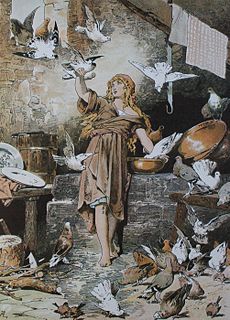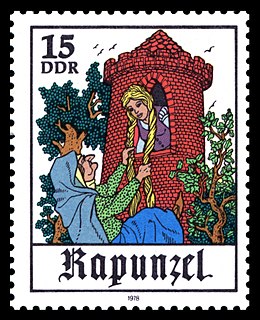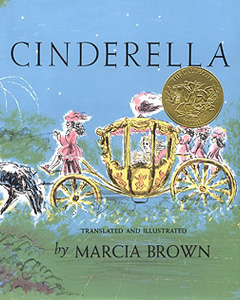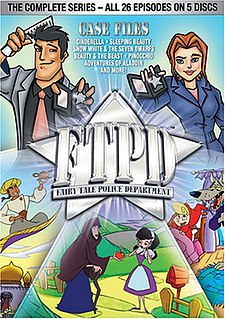
"Cinderella", or "The Little Glass Slipper", is a folk tale about oppression and triumphant reward. Thousands of variants are known throughout the world. The protagonist is a young woman living in forsaken circumstances that are suddenly changed to remarkable fortune, with her ascension to the throne via marriage. The story of Rhodopis, recounted by the Greek geographer Strabo sometime between around 7 BC and AD 23, about a Greek slave girl who marries the king of Egypt, is usually considered to be the earliest known variant of the Cinderella story.

Rapunzel is a German fairy tale recorded by the Brothers Grimm and first published in 1812 as part of Children's and Household Tales. The Brothers Grimm's story is an adaptation of the fairy tale Rapunzel by Friedrich Schulz (1790) that was a translation of Persinette (1698) by Charlotte-Rose de Caumont de La Force, which was itself influenced by an earlier Italian tale, Petrosinella (1634), by Giambattista Basile.

In fairy tales, a fairy godmother is a fairy with magical powers who acts as a mentor or parent to someone, in the role that an actual godparent was expected to play in many societies. In Perrault's Cinderella, he concludes the tale with the moral that no personal advantages will suffice without proper connections.

Rodgers and Hammerstein's Cinderella is a musical written for television, but later played on stage, with music by Richard Rodgers and a book and lyrics by Oscar Hammerstein II. It is based upon the fairy tale Cinderella, particularly the French version Cendrillon, ou la petite pantoufle de verre, by Charles Perrault. The story concerns a young woman forced into a life of servitude by her cruel stepmother and self-centered stepsisters, who dreams of a better life. With the help of her Fairy Godmother, Cinderella is transformed into a Princess and finds her Prince.

Queen Zixi of Ix, or The Story of the Magic Cloak, is a children's book written by L. Frank Baum and illustrated by Frederick Richardson. It was originally serialized in the early 20th-century American children's magazine St. Nicholas from November 1904 to October 1905, and was published in book form later in 1905 by The Century Company. The events of the book alternate between Noland and Ix, two neighboring regions to the Land of Oz, and Baum himself commented this was the best book he had written. In a letter to his eldest son, Frank Joslyn Baum, he said it was "nearer to the "old-fashioned" fairy tale than anything I have yet accomplished," and in many respects, it adheres more closely to the fairy tale structure than the Oz books.
The Sisters Grimm is a children's fantasy series written by Michael Buckley and illustrated by Peter Ferguson. The series features two sisters, Sabrina Grimm and Daphne Grimm, and consists of nine novels that were published from 2005 to 2012.

The Frog Prince, Continued (ISBN 0-590-98167-6) by Jon Scieszka is a picture book parody "sequel" to the tale of The Frog Prince, in which a princess kisses a frog which then turns into a prince. It was first published in 1991.
The Princess Mayblossom is a French literary fairy tale written by Madame d'Aulnoy in 1697. Andrew Lang included it in The Red Fairy Book.
Lion of Oz is a 2000 animated film set before the 1900 children's novel The Wonderful Wizard of Oz. It tells the story of how the Cowardly Lion, formerly part of the Omaha Circus, came to be in Oz and how he stopped the Wicked Witch of the East from getting the Flower of Oz. It is based upon the 1995 book Lion of Oz and the Badge of Courage by Roger S. Baum.

The Sea Fairies is a children's fantasy novel written by L. Frank Baum, illustrated by John R. Neill, and published in 1911 by the Reilly & Britton Company, the publisher of Baum's series of Oz books.

Cinderella, or the Little Glass Slipper is a book illustrated by Marcia Brown. Released by Scribner Press, the book is a retelling of the story of Cinderella as written by Charles Perrault, and was the recipient of the Caldecott Medal for illustration in 1955. The book takes place in France, in a palace similar to other Cinderella stories.

Cinderella Monogatari is an Italian-Japanese 1996 anime television series based on the fairytale of the same name by Charles Perrault and The Brothers Grimm. It was produced by Tatsunoko Productions and Mondo TV. The series originally aired from April 4 to October 3, 1996, comprising 26 episodes.

Cinderella is a 1977 American erotic musical comedy film directed by Michael Pataki and starring Cheryl "Rainbeaux" Smith, Brett Smiley, and Sy Richardson.
The Practical Princess and other Liberating Fairy Tales is a collection of six short stories, written by Jay Williams, in 1979, and published by Hippo from Scholastic. Each story features nods in some way to classic Fairy tales.

The Land of Stories is a series of children's fiction, adventure and fantasy books written by American author, actor and singer Chris Colfer. The first book, The Wishing Spell, was released on July 17, 2012. The sixth book was published in July 2017. During a live video chat, Colfer revealed plans for a prequel series, which have now been published. The books are described by Colfer as a "modern-day fairy tale", following twins Alex and Conner Bailey as they fall from the real world into a world full of fairy tales they have only ever read about before and discovering there is more to this world than meets the eye.

Fairy Tale Police Department is a 2001 Australian animated series, produced by the company Yoram Gross-EM.TV in co-production with EM.TV & Merchandising AG, Victory Media Group, and Talit Communications. It aired on Seven Network at various times. Known as La Brigade des Contes de Fées in France, the film offers a new perspective on classic fairy tales through the central characters Johnny Legend Fantasy and Christine Anderson. They are magic police officers who restore balance to society.

Flora, Fauna, and Merryweather are the three good fairies in Walt Disney's 1959 film Sleeping Beauty. They are characterized as Princess Aurora's fairy godmothers and guardians, who appear at baby Aurora's christening to present their gifts to her. The three were voiced by Verna Felton, Barbara Jo Allen, and Barbara Luddy, respectively.












